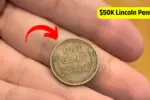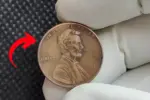Imagine the thrill of discovering a rare treasure hidden in plain sight a simple penny that could be worth millions. For coin enthusiasts and history lovers, the Lincoln Wheat Penny represents a fascinating chapter in American numismatic history. Among these pennies, the 1943 copper Lincoln Wheat Penny stands as a symbol of rarity and immense value. With a staggering worth of $3.3 million, this coin has become legendary. What’s even more exciting is that some of these valuable pennies might still be in circulation today, waiting to be discovered.
In this article, we’ll delve into the story of the Lincoln Wheat Penny, why it’s so special, and how you can identify one of these remarkable coins.
What Makes the Lincoln Wheat Penny Special?
The Lincoln Wheat Penny, first minted in 1909, holds the distinction of being the first U.S. coin to feature a real historical figure President Abraham Lincoln. Designed by Victor D. Brenner, the coin’s obverse showcases Lincoln’s portrait, while its reverse bears the image of two wheat stalks, symbolizing growth and prosperity. The penny was introduced to commemorate Lincoln’s 100th birthday, and its iconic design has made it a favorite among collectors.
While most Lincoln Wheat Pennies were crafted from copper, the year 1943 marked a unique deviation. During World War II, copper became a critical material needed for wartime production. To conserve copper for military supplies, the U.S. Mint switched to producing pennies from zinc-coated steel. However, due to an accidental minting error, a few pennies were struck in copper instead of steel. These rare 1943 copper pennies are now among the most valuable coins in the world.
The Fascinating History Behind the 1943 Copper Penny
The 1943 copper Lincoln Wheat Penny is a result of human error during a pivotal moment in history. In 1943, the U.S. Mint was fully committed to supporting the war effort. Copper, being a vital resource, was redirected from coin production to manufacturing ammunition and other military supplies. The decision to use zinc-coated steel for pennies was a practical solution to conserve resources.
Despite this change, it is believed that a small number of copper blanks were left in the coin presses and mistakenly used to produce pennies. These copper pennies were released into circulation, unnoticed at first. Over time, their rarity and historical significance became apparent, and they gained immense value in the numismatic world.
Why Is the 1943 Copper Penny Worth $3.3 Million?
The value of the 1943 copper Lincoln Wheat Penny can be attributed to several factors:
- Rarity: Only a handful of these pennies are known to exist, making them exceptionally rare and highly sought after.
- Minting Error: The accidental use of copper instead of steel makes these coins unique and adds to their allure.
- Historical Importance: These pennies represent a critical period in U.S. history during World War II, highlighting the country’s efforts to conserve resources.
- Collector Demand: Numismatists and collectors are willing to pay millions for one of these rare coins, driving up their market value.
The record-breaking $3.3 million price tag for one of these pennies showcases the extraordinary demand and appreciation for its rarity and historical significance.
How to Identify a Valuable 1943 Copper Penny
If you’re wondering whether you might have a 1943 copper penny in your possession, here’s how you can identify one:
- Material Test: The easiest way to determine if a penny is copper is to check if it sticks to a magnet. Zinc-coated steel pennies will stick to a magnet, whereas copper pennies will not.
- Mint Mark: Examine the coin for its mint mark, located below the date on the obverse side. The 1943 penny was minted in three locations Philadelphia (no mint mark), Denver (D), and San Francisco (S). Copper versions with different mint marks have been found.
- Weight: Copper pennies weigh slightly more than steel pennies. You can use a precise scale to check the weight of the coin.
- Condition: Coins in pristine condition, free of scratches and wear, are worth significantly more than those that are worn or damaged.
Keep in mind that there are counterfeit versions of the 1943 copper penny, so it’s important to consult an expert or get your coin authenticated by a reputable grading service.
Could This $3.3 Million Penny Still Be in Circulation?
The idea that a $3.3 million penny could still be out there is both thrilling and plausible. Coins often circulate for decades, passing through countless hands. Some rare finds have been discovered in old piggy banks, forgotten collections, and even in loose change from everyday transactions. While the chances of finding a 1943 copper penny are slim, the possibility exists, which makes checking your change an exciting endeavor.
Other Valuable Lincoln Wheat Pennies
While the 1943 copper penny is the crown jewel of Lincoln Wheat Pennies, there are other valuable pennies worth looking for:
- 1909-S VDB: This penny, from the first year of production, features the designer’s initials “V.D.B.” on the reverse side. It is highly sought after by collectors.
- 1914-D: A rare penny minted in Denver, known for its scarcity.
- 1922 Plain: A penny with no mint mark due to a minting error, making it unique and valuable.
- 1955 Doubled Die: A fascinating error coin where the date and inscriptions appear doubled.
Each of these pennies holds its own story and value, adding to the charm of collecting Lincoln Wheat Pennies.
Tips for Coin Collectors
If you’re new to coin collecting or looking to enhance your collection, here are some helpful tips:
- Educate Yourself: Learn about different coins, their history, and their characteristics. Knowledge is key to identifying valuable coins.
- Invest in Tools: A magnifying glass, magnet, and precise scale can help you examine coins more effectively.
- Check Your Change: Always inspect your pocket change and look out for pennies with unique features or minting errors.
- Connect with Others: Join coin-collecting communities or forums to share insights and learn from experienced collectors.
- Preserve Your Coins: Store your coins in protective cases or holders to prevent damage and maintain their value.
Conclusion
The Lincoln Wheat Penny is more than just a piece of currency; it’s a historical artifact that connects us to the past. Whether you’re a seasoned collector or simply curious about the coins you encounter in daily life, the possibility of finding a rare and valuable penny is an exciting prospect. The story of the 1943 copper penny serves as a reminder that even the smallest and most ordinary objects can hold extraordinary value. So, the next time you receive change, take a closer look you might just uncover a hidden treasure.
FAQs
What is a Lincoln Wheat Penny?
A U.S. penny minted from 1909 to 1958 featuring wheat stalks on the reverse side.
Why is the 1943 copper penny so valuable?
Because it was mistakenly struck in copper during a year when steel was used instead.
How can I tell if my penny is rare?
Check the date, mint mark, material, and consult a professional appraiser.
What does MS-68 RD mean in coin grading?
It means the coin is in mint condition with full red copper coloring.
Where can I get my coin graded?
Trusted grading services include PCGS and NGC.



